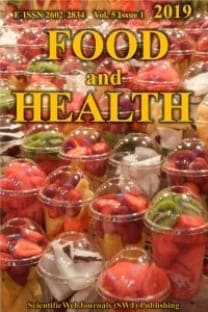Curcumin's antioxidant effects on inflammatory diseases
There are similar inflammatory reasons behind non-contagious chronic diseases. The prevalence of these diseases increases everyday both in our country and around the world. That's why scientists have begun looking for strong antioxidants that could help prevent and treat such inflammatory diseases. Curcumin is one of those antioxidants. Curcumin is one of the components of turmeric, which belongs to the ginger family. Many studies showed that the curcuminoids in turmeric can be used to prevent and treat cardiovascular, autoimmune and endocrine diseases, cancer as well as various inflammatory diseases. With this study, we aim to interpret these recent studies conducted with curcumin.
___
- Akremi, N., Cappoen, D., Anthonissen, R., Bouraoui, A., Verschaeve, L. (2016). Evaluation of the genotoxicity and cytotoxicity of semipurified fractions from the Mediterranean brown algae, Dictyopteris membranacea. Pharmacognosy Magazine, 12(Suppl 4), S395. https://doi.org/10.4103/0973-1296.188318
- Al-Enazi, N.M., Awaad, A.S., Zain, M.E., Alqasoumi, S.I. (2018). Antimicrobial, antioxidant and anticancer activities of Laurencia catarinensis, Laurencia majuscula and Padina pavonica extracts. Saudi Pharmaceutical Journal, 26(1), 44- 52. https://doi.org/10.1016/j.jsps.2017.11.001
- Atmaca, H., İlhan, S., Batır, B., Pulat, Ç. Ç., Güner, A., Bektaş, H. (2020). Novel benzimidazole derivatives: Synthesis, in vitro cytotoxicity, apoptosis and cell cycle studies. Chemico-Biological Interactions, 109163. https://doi.org/10.1016/j.cbi.2020.109163
- Bello, A., Padmanabhan, S., Thangamalai, R., Lakshmanan, K., Nagarajan, K. (2019). Evaluation of genotoxic effects of methanolic extract of brown seaweed Stoechospermum marginatum. The Journal of Phytopharmacology, 8(5), 226-231. https://doi.org/10.31254/phyto.2019.8504
- Cherry, P., O'Hara, C., Magee, P.J., McSorley, E.M., Allsopp, P.J. (2019). Risks and benefits of consuming edible seaweeds. Nutrition Reviews, 77(5), 307-329. https://doi.org/10.1093/nutrit/nuy066
- Das, B.C. (1988). Factors that influence formation of sister chromatid exchanges in human blood lymphocytes. CRC Critical Reviews in Toxicology, 19(1), 43-86. https://doi.org/10.3109/10408448809040817
- Evans, H.J., O’Riordan, M.L. (1975). Human peripheral blood lymphocytes for the analysis of chromosome aberrations in mutagen tests. Mutation Research, 31, 135-148. https://doi.org/10.1016/0165-1161(75)90082-5
- Field, C.B., Behrenfeld, M.J., Randerson, J.T., Falkowski, P. (1998). Primary production of the biosphere: integrating terrestrial and oceanic components. Science, 281, 237-240. https://doi.org/10.1126/science.281.5374.237
- Fenech, M. (1993). The cytokinesis-block micronucleus technique: a detailed description of the method and its application to genotoxicity studies in human populations. Mutation Research, 285, 35-44. https://doi.org/10.1016/0027-5107(93)90049-L
- Güner, A., Türkez, H., Aslan, A. (2012). The In Vitro Effects of Dermotocarpon Intestiniforme (A Lichen) Extracts Against Cadmium Induced Genetic and Oxidative Damage. Ekoloji. 21(84), 38-46. https://doi.org/10.5053/ekoloji.2012.845
- Güner, A., Köksal, Ç., Erel, Ş.B., Kayalar, H., Nalbantsoy, A., Sukatar, A., Karabay Yavaşoğlu, N.Ü. (2015). Antimicrobial and antioxidant activities with acute toxicity, cytotoxicity and mutagenicity of Cystoseira compressa (Esper) Gerloff & Nizamuddin from the coast of Urla (Izmir, Turkey). Cytotechnology, 67, 135-143. https://doi.org/10.1007/s10616-013-9668-x
- Güner, A., Karabay Yavasoğlu, N.U. (2018). Evaluation of antioxidant, antimicrobial and antimutagenic activity with irritation effects of Ceramium rubrum (Red Algae) extract. International Journal of Secondary Metabolite, 5, 279-287. https://doi.org/10.21448/ijsm.432654
- Güner, A., Nalbantsoy, A., Sukatar, A., Karabay Yavaşoğlu, N.Ü. (2019). Apoptosis-inducing activities of Halopteris scoparia L. Sauvageau (brown algae) on cancer cells and its biosafety and antioxidant properties. Cytotechnology, 71(3), 687-704. https://doi.org/10.1007/s10616-019-00314-5
- Güner, Ö., Güner, A., Yavaşoğlu, A., Karabay Yavaşoğlu, N.Ü., Kavlak, O. (2020). Ameliorative effect of edible Halopteris scoparia against cadmium-induced reproductive toxicity in male mice: A biochemical and histopathologic study. Andrologia, 52(6), e13591. https://doi.org/10.1111/and.13591
- Khaled, N., Hiba, M., Asma, C. (2012). Antioxidant and Antifungal Activities of Padina pavonica and Sargassum vulgare from the Lebanese Mediterranean Coast. Advances in Environmental Biology, 6, 42-48.
- Khanavi, M., Nabavi, M., Sadati, N., Shams Ardekani, M., Sohrabipour, J., Nabavi, S.M.B., Ghaeli P., Ostad, S.N. (2010). Cytotoxic activity of some marine brown algae against cancer cell lines. Biological Research, 43(1), 31-37. https://doi.org/10.4067/S0716-97602010000100005
- Kim, K.J., Lee, O.H., Lee, B.Y. (2010). Genotoxicity studies on fucoidan from Sporophyll of Undaria pinnatifida. Food and Chemical Toxicology, 48(4), 1101-1104. https://doi.org/10.1016/j.fct.2010.01.032
- Kusano, C., Ferrari, B. (2008). Total antioxidant capacity: a biomarker in biomedical and nutritional studies. Journal of Molecular Cell Biology, 7, 1-15.
- Mashjoor, S., Yousefzadi, M., Esmaeili, M.A., Rafiee, R. (2016). Cytotoxicity and antimicrobial activity of marine macroalgae (Dictyotaceae and Ulvaceae) from the Persian Gulf. Cytotechnology, 68(5), 1717-1726. https://doi.org/10.1007/s10616-015-9921-6
- McHugh, D.J. (2003). A guide to the seaweed industry. FAO Fish Tech Pap 441, Rome, Italy, p 105, ISBN 92-5-104958-0
- Migliore, L., Nieri, M., Amodio, S., Loprieno, N. (1989). The human lymphocyte micronucleus assay: a comparison between whole-blood and separated-lymphocyte cultures. Mutation Research Letters, 227(3), 167-172. https://doi.org/10.1016/0165-7992(89)90041-9
- Mohamed, S., Hashim, S.N., Rahman, H.A. (2012). Seaweeds: a sustainable functional food for complementary and alternative therapy. Trends in Food Science & Technology, 23, 83-96. https://doi.org/10.1016/j.tifs.2011.09.001
- Pereira, L. (2016). Edible seaweeds of the world. CRC Press, Boca Raton, p 52. ISBN: 13:978-1-4987-3050-1 https://doi.org/10.1201/b19970
- Roopashree, K.M., Naik, D. (2019). Advanced method of secondary metabolite extraction and quality analysis. Journal of Pharmacognosy and Phytochemistry, 8(3), 1829-1842.
- Song, M.Y., Ku, S.K., Han, J.S. (2012). Genotoxicity testing of low molecular weight fucoidan from brown seaweeds. Food and Chemical Toxicology, 50(3-4), 790-796. https://doi.org/10.1016/j.fct.2011.11.010
- Stanojkovic, T.P., Savikin, K., Zdunic, G., Kljajic, Z., Grozdanic, N., Antic, J. (2013). In Vitro Antitumoral Activities of Padina pavonica on Human Cervix and Breast Cancer Cell Lines. Journal of Medicinal Plants Research, 7, 419- 424.
- ISSN: 2602-2834
- Yayın Aralığı: Yılda 4 Sayı
- Başlangıç: 2018
- Yayıncı: ScientificWebJournals (SWJ) Özkan Özden
Sayıdaki Diğer Makaleler
Nazlı SÖYLER, Mehmet Sedat İPAR, DEMET KOCATEPE
A potential antiviral and food-derived healthy ingredient: Resveratrol
Curcumin's antioxidant effects on inflammatory diseases
Afyonkarahisar’da satışa sunulan kıymalarda Aeromonas spp. varlığının araştırılması
RECEP KARA, ULAŞ ACARÖZ, Zeki GÜRLER, Fahriye ZEMHERİ NAVRUZ, Ali SOYLU
Curcumin's antioxidant effects on inflammatory diseases
Burcu İrem OMURTAG KORKMAZ, Ayça AYDIN, Neşe KILIÇ
In vitro risk assessment of Padina pavonica (Linnaeus) (Brown algae)
